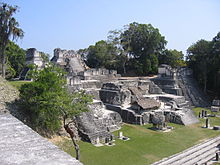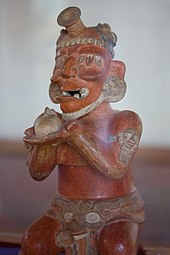Tikal
During this time, the city dominated much of the Maya region politically, economically, and militarily, while interacting with areas throughout Mesoamerica such as the great metropolis of Teotihuacan in the distant Valley of Mexico.
[23] At the end of the Late Preclassic, the Izapan style art and architecture from the Pacific Coast began to influence Tikal, as demonstrated by a broken sculpture from the acropolis and early murals at the city.
The site was defeated at the end of the Early Classic by Caracol, which rose to take Tikal's place as the paramount center in the southern Maya lowlands.
[37] Siyaj Kʼakʼ was probably a foreign general serving a figure represented by a non-Maya hieroglyph of a spearthrower combined with an owl, a glyph that is well known from the great metropolis of Teotihuacan in the distant Valley of Mexico.
These recorded events strongly suggest that Siyaj Kʼakʼ led a Teotihuacan invasion that defeated the native Tikal king, who was captured and immediately executed.
[38] Siyaj Kʼakʼ appears to have been aided by a powerful political faction at Tikal itself;[39] roughly at the time of the conquest, a group of Teotihuacan natives were apparently residing near the Lost World complex.
[23][41] Within a year, the son of Spearthrower Owl by the name of Yax Nuun Ahiin I (First Crocodile) had been installed as the fifteenth king of Tikal while he was still a boy, being enthroned on 13 September 379.
It seems likely that Yax Nuun Ayiin I took a wife from the preexisting, defeated, Tikal dynasty and thus legitimized the right to rule of his son, Siyaj Chan Kʼawiil II.
[40] Around the 5th century, an impressive system of fortifications consisting of ditches and earthworks was built along the northern periphery of Tikal's hinterland, joining up with the natural defenses provided by large areas of swampland lying to the east and west of the city.
[45] Kʼinich Yax Kukʼ Moʼ arrived in Copán in December 426, and bone analysis of his remains shows that he passed his childhood and youth at Tikal.
[69] Increasingly endemic warfare in the Maya region caused Tikal's supporting population to heavily concentrate close to the city itself, accelerating the use of intensive agriculture and the corresponding environmental decline.
[74] In the latter half of the 9th century, there was an attempt to revive royal power at the much-diminished city of Tikal, as evidenced by a stela erected in the Great Plaza by Jasaw Chan Kʼawiil II in 869.
The squatters blocked some doorways in the rooms they reoccupied in the monumental structures of the site and left rubbish that included a mixture of domestic refuse and non-utilitarian items such as musical instruments.
The fall of Tikal was a blow to the heart of Classic Maya civilization, the city having been at the forefront of courtly life, art and architecture for over a thousand years, with an ancient ruling dynasty.
Dotleaf waterlilies, have bluish undersides that prevent passage of light and thus minimizes algae growth, inhibits evaporation, provides shade for predators of pests, removes nitrogen through their roots, and serves as an indicator of acidic conditions as water lilies cannot tolerate low pH levels;[104][105] low pH levels have been linked to tooth corrosion and disruption of gut homeostasis.
[101] A significant proportion of royal power rested in what the ruling party could materially provide for their subjects (i.e. water during annual drought through massive artificial reservoirs).
[92] The North Acropolis, together with the Great Plaza immediately to the south, is one of the most studied architectural groups in the Maya area; the Tikal Project excavated a massive trench across the complex, thoroughly investigating its construction history.
It developed into a funerary complex for the ruling dynasty of the Classic Period, with each additional royal burial adding new temples on top of the older structures.
[20] Among items recovered from the Late Classic tomb were a large collection of inscribed human and animal bone tubes and strips with sophisticated scenes depicting deities and people, finely carved and rubbed with vermilion, as well as jade and shell ornaments and ceramic vessels filled with offerings of food and drink.
It stood 55 meters (180 ft) tall and contained an elaborately sculpted but damaged roof lintel, possibly showing Dark Sun engaged in a ritual dance around AD 810.
[97] It attained its final form during the reign of Chak Tok Ichʼaak in the 4th century AD, in the Early Classic, standing more than 30 meters (98 ft) high with stairways on all four sides and a flat top that possibly supported a superstructure built from perishable materials.
[134][138] Although the plaza later suffered significant alteration, the organization of a group of temples on the east side of this complex adheres to the layout that defines the so-called E-Groups, identified as solar observatories.
It lies a few hundred m south of the Lost World Complex and the excavations have revealed elaborate stucco masks, ballplayer murals, relief sculptures and buildings with Teotihuacan characteristics.
The defaced portrait on the monument is that of the so-called "Lady of Tikal", a daughter of Chak Tok Ichʼaak II who became queen at the age of six but never ruled in her own right, being paired with male co-rulers.
The stela was deliberately smashed during the 6th century or some time later, the upper portion was dragged away and dumped in a rubbish tip close to Temple III, to be uncovered by archeologists in 1959.
[162] Stela 31 is the accession monument of Siyaj Chan K'awiil II, also bearing two portraits of his father, Yax Nuun Ayiin, as a youth dressed as a Teotihuacan warrior.
A long hieroglyphic text is carved onto the back of the monument, the longest to survive from the Early Classic,[169] which describes the arrival of Siyah Kʼakʼ at El Peru and Tikal in January 378.
[172] Stela 32 is a fragmented monument with a foreign Teotihuacan-style sculpture apparently depicting the lord of that city with the attributes of the central Mexican storm god Tláloc, including his goggle eyes and tasselled headdress.
A fine ceramic bowl was recovered from the tomb, with the handle formed from three-dimensional head and neck of a bird emerging from the two-dimensional body painted on the lid.
[171] Among the offerings was an incense-burner in the shape of an elderly underworld god, sitting on a stool made of human bones and holding a severed head in his hands.
















